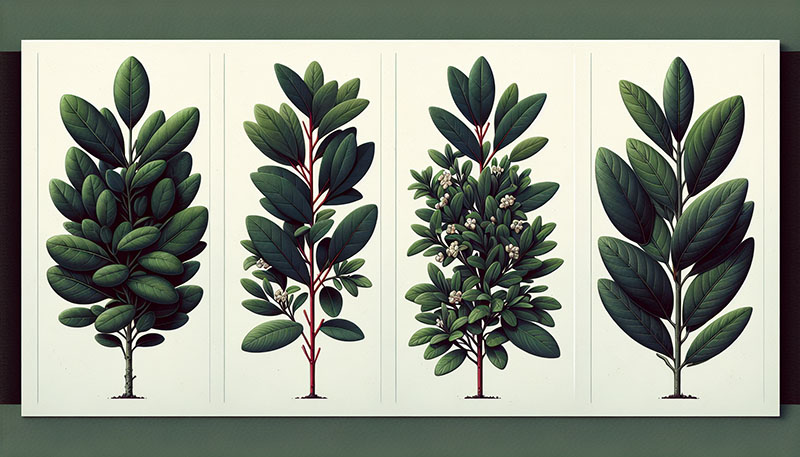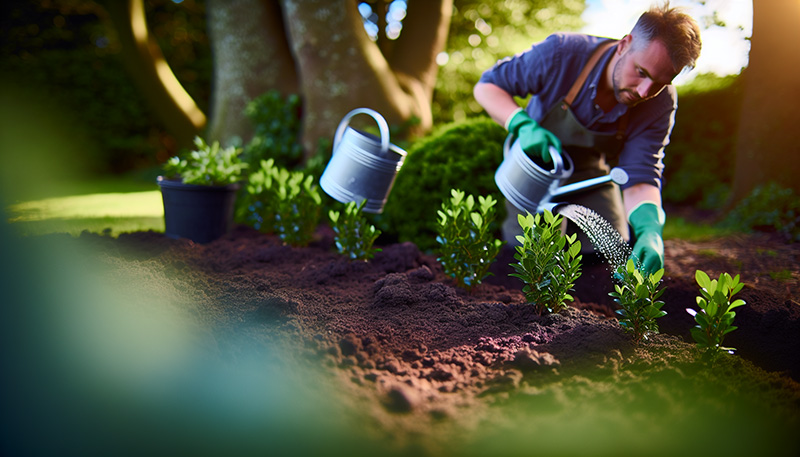Welcome to the world of laurel hedging, a vibrant universe of lush greenery that can transform your garden into a private sanctuary. Whether you’re an experienced gardener or a novice green thumb, laurel hedges provide a versatile and resilient option to add privacy, beauty, and year-round greenery to your outdoor space. So let’s embark on this journey of green transformation together.
Key Takeaways
- This guide provides an overview of the types and benefits of Laurel hedging plants, including Cherry, Portuguese, and Bay Laurel.
- Planting a laurel hedge requires selecting the right location for optimal growth. Preparing soil with proper drainage & organic matter. Planting in mid-autumn. Regular watering to keep soil moist.
- Caring for your laurel hedge involves pruning regularly to maintain shape & promote lushness. Pest/disease control via preventative measures such as sanitation & fertilizing with balanced fertilizer plus mulching with bark mulch.
Understanding Laurel Hedging: Types and Benefits

Laurel hedging plants are renowned for their robust evergreen nature and vibrant bright green foliage, a sight to behold in any garden. Their white flowers bloom in the spring, adding a delicate touch to your garden. These flowers eventually transition into festive red berries lasting through winter, providing year-round interest. As a popular hedging plant, the most common types of Laurel hedging, Cherry and Portuguese, are both well-known laurel plants that offer a wealth of practical benefits, including year-round coverage, visual appeal, and the capacity to thrive in difficult conditions.
But the world of laurel hedges is not limited to just these two. It’s a broad spectrum of species, each with its unique characteristics and appeal. And it’s worth noting that although these plants are a common sight in many gardens, all laurels, apart from Bay Laurel, are toxic to livestock and animals, making Bay Laurel an ideal choice for households with pets and children.
This comprehensive guide will detail the distinguishing features of Cherry, Portuguese, and Bay Laurel that make them excellent choices for your garden. Buy Laurel Hedging here
Cherry Laurel: A Dense Privacy Screen
When thinking of a hedge that offers a dense privacy screen, cherry laurel comes to mind. This fast-growing evergreen hedge can be easily pruned to maintain its shape and size, making it an ideal choice for those desiring a natural barrier in their garden. But it’s not just about the privacy; it’s about the versatility. Cherry laurel thrives in a variety of conditions, including full shade and most soils, although coastal areas or alkaline soil may not be the best fit.
The resilience of the cherry laurel is notably admirable. It’s a plant that has adapted itself to a variety of conditions, proving itself to be a truly versatile choice for your garden. Regardless of your home’s location, in a busy city or peaceful countryside, the cherry laurel can establish a calm, green oasis with its dense and sturdy growth.
Portuguese Laurel: Elegant and Hardy
If elegance and hardiness are what you seek in a hedging plant, then Portuguese laurel, a variety of prunus laurocerasus, is the choice for you. Known for its elegant aesthetic and robustness, it produces delicate sprays of white fragrant blossoms in springtime and small red-purple fruits later in the year, adding an extra charm to your garden.
What sets Portuguese laurel apart from its counterparts is its rapid rate of growth. In just a few years, this plant can easily reach a height of 8 feet, making it an ideal choice for those who want to create a tall and dense hedge fast. And with its versatility and ability to withstand various soil types and climatic conditions, Portuguese laurel is sure to be a star in your garden, no matter where you live.
Bay Laurel: Fragrant and Culinary Uses
Diving into the world of laurels, one cannot overlook the Bay Laurel and the Common Laurel. Esteemed for their aromatic foliage and culinary applications, these plants bring a fragrant charm to your kitchen garden or topiary. The Mediterranean native Bay Laurel is not just about the looks; its leaves add flavor to a variety of dishes, from Gordon Ramsay’s Pomme Purée to Caribbean jerk chicken, and even simple, comforting soups.
However, while they are attractive, it’s important to remember that Bay Laurel leaves should not be consumed directly. When cooking, they are added to the dish to infuse their flavors and are removed before serving, as they remain tough and unpleasant to eat. With its dual benefits of beauty and flavor, Bay Laurel truly embodies the essence of a functional and appealing garden.
Planting Your Laurel Hedge: Tips and Techniques

Having examined various types of laurel hedges, we now turn our focus to the engaging aspect – planting your own laurel hedge. From choosing the right location to preparing the soil and planting, each step is a journey in itself, shaping the future of your green sanctuary. Rest assured, we will guide you throughout the process, helping you cultivate a thriving and flourishing laurel hedge in your garden.
Picking the perfect spot for your laurel hedge is not just about aesthetics; it’s about understanding the needs of the plant. The right location, combined with well-prepared soil, can set the foundation for a thriving laurel hedge. Then comes the planting process, where your laurel hedge starts its journey from a mere sapling to a robust, lush green hedge. We’ll detail these steps more explicitly in the upcoming subsections.
Choosing the Right Location
Selecting the optimal location for your laurel hedge is similar to choosing a home. It’s about finding that perfect spot where your laurel hedge will flourish, receiving the right amount of sunlight and having access to suitable soil.
But it’s not just about the plant’s needs; it’s about planning your garden layout. You need to consider the spacing for your laurel hedge to ensure optimal growth. As a rule of thumb, laurel hedges should be spaced approximately 2-3 feet apart. This spacing allows each plant to have enough room to grow, while also ensuring a dense hedge.
Preparing the Soil
With the right location chosen, the next step in your laurel hedge journey is preparing the soil. This process could be compared to preparing a stage for a performance, with the soil acting as the backdrop, supplying the necessary nutrients and environment for the laurel hedge’s growth.
The best kind of soil for laurel hedges is well-drained soil. However, laurels are quite accommodating and can endure a broad array of soil types, including clay and sandy loam. But no matter the soil type, the key is to ensure proper drainage. This can be achieved by adding organic matter such as compost or well-rotted manure to the soil, which not only improves drainage but also enhances the soil’s fertility.
Planting and Watering
With the location chosen and soil prepared, it’s time to plant your laurel hedge. The planting process is like a rite of passage, where your laurel hedge transitions from a sapling to an established member of your garden. Whether you’re planting:
- bare-root plants
- root ball
- pot and cell grown
- topiary trees
- instant hedging
The process remains the same, even when aiming to decrease quantity on a full page, opening a new window, or dealing with open media, as every sale sold with tax included follows these steps.
Planting is best done in mid-autumn, when the soil is still warm from summer, but the cooler temperatures can help prevent the plants from drying out. When planting, ensure that the hole is wide and deep enough to accommodate the root ball of the laurel. Once planted, the laurel hedge should be watered thoroughly and regularly, ensuring the soil remains moist but not waterlogged.
Caring for Your Laurel Hedge: Maintenance and Pruning

While planting your laurel hedge is an exciting process, care and maintenance are crucial for its long-term growth and health. From pruning for optimal growth to pest and disease control, and fertilizing and mulching, each step is integral to nurturing a thriving laurel hedge. But fear not, we’re here to guide you through the process, and ensure your laurel hedge remains a vibrant part of your garden year-round.
Pruning is an essential part of maintaining your laurel hedge. Not only does it help maintain the shape and size of the hedge, but it also encourages dense growth, ensuring a lush and healthy hedge. But that’s not all, taking care of your laurel hedge also includes keeping an eye out for pests and diseases, and providing the necessary nutrients through fertilizing and mulching. We’ll examine these facets more in depth in the upcoming subsections.
Pruning for Optimal Growth
Pruning can be compared to giving your laurel hedge a haircut. It’s about maintaining its shape and size, while also encouraging new growth. Pruning is not just about aesthetics; it’s a vital process that helps your laurel hedge grow dense and lush.
Pruning should ideally be done in June or September, allowing the hedge to recover and put on new growth before the onset of winter. Regular pruning, about two or three times a year, helps maintain the hedge’s shape and promotes healthy growth from top to bottom. Don’t hesitate to trim your laurel hedge; it’s all part of nurturing its lush and beautiful growth.
Pest and Disease Control
While laurel hedges are generally hardy, they can sometimes fall prey to pests and diseases. Some common pests and diseases that can affect laurel hedges include:
- Aphids
- Scale insects
- Powdery mildew
- Shot-hole disease
Identifying these issues at an early stage can help prevent damage to your laurel hedge. Here are some steps you can take to maintain a healthy laurel hedge:
- Regularly inspect your hedge for signs of pests or diseases.
- Apply appropriate fungicides to prevent fungal infections.
- Practice proper pruning and sanitation to remove any infected or damaged branches.
- Ensure your hedge is well-watered and receives adequate sunlight.
- Keep the area around your hedge clean and free from debris. By following these steps, you can help keep your laurel hedge healthy and free from pests and diseases.
Fertilizing and Mulching
Just like us, plants too need a balanced diet to grow healthy and strong. Fertilizing and mulching are two crucial practices that provide essential nutrients and maintain soil moisture for laurel hedges.
For fertilizing, a balanced fertilizer such as Growmore is ideal. It should be applied as per the instructions on the packaging, ensuring the laurel hedge gets the nutrients it needs.
Mulching, on the other hand, helps retain moisture in the soil, suppress weeds, and enrich the soil. Bark mulch is particularly beneficial for laurel hedges, as it creates a protective barrier against weeds and retains moisture at the root.
Summary
From understanding the different types of laurels to planting, caring, and exploring alternatives, we’ve covered a lot in this journey of creating the perfect laurel hedge. Remember, whether it’s a cherry laurel offering a dense privacy screen or a fragrant bay laurel adding flavor to your dishes, each laurel hedge has its unique charm. So go ahead, take the plunge and let the joy of gardening transform your outdoor space into a lush, green haven.
Frequently Asked Questions
What is the downside of a Laurel hedge?
Laurel hedges are prone to frost damage during the winter months, which can cause discolored and curled leaves.
How fast does Laurel hedge grow?
Laurel hedge typically grows between 30-60 cm each year, making it a fast-growing variety.
What is the best Laurel hedge in Ireland?
For the best Laurel hedge in Ireland, the most common suggestion is the Common or Cherry Laurel group (Prunus laurocerasus) or the Portugal Laurel, with Bay Laurel as a useful additional option.
What month is best to plant laurels?
For successful laurel planting, November to March is the best time frame due to plants being dormant over the winter.
